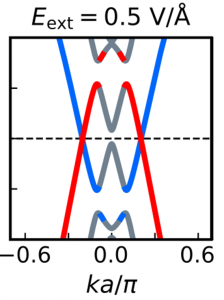M. Pizzochero, N. V. Tepliakov, A. A. Mostofi and E. Kaxiras, Electrically Induced Dirac Fermions in Graphene Nanoribbons, Nano Letters 21, 9332 (2021).
Graphene nanoribbons (GNRs) are few-nanometer wide strips of graphene. Unlike graphene, graphene nanoribbons have a band-gap, while still maintaining high electron and hole mobility. This makes them promising candidates for beyond-silicon nanoelectronic devices.
In this work we used first-principles calculations and simpler tight-binding models to explore whether and to what degree the properties of graphene nanoribbons can be controlled by an electric field. This is of crucial importance for developing electronic devices based on graphene nanoribbons. We showed that applying an electric field across the width of the nanoribbon modulates the size of the band-gap, and can be used to turn a normally semiconducting nanoribbon into a semimetal. The electrically-induced semimetallic phase features zero-energy massless Dirac fermions, analogous to graphene. The electric field can be applied externally, i.e., by contacting the edges of the nanoribbon to source and drain electrodes, or internally, by incorporating doping elements of opposite polarity in the opposite edges of the nanoribbon. These findings generalize to other group-IV nanoribbons, including recently fabricated silicene nanoribbons, which hold great promise due to their potential for integration into current silicon electronics.
This work was part of the PhD work of Nikita Tepliakov and was in collaboration with colleagues Michele Pizzochero and Efthimios Kaxiras at Harvard University.
